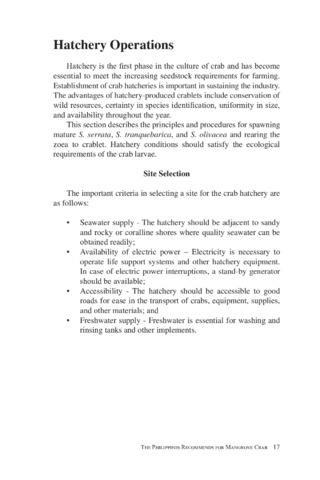Domestication of the mud crab Scylla serrata
| dc.contributor.author | Quinitio, Emilia T. | |
| dc.contributor.author | de la Cruz, Joana Joy | |
| dc.contributor.author | Eguia, Maria Rowena R. | |
| dc.contributor.author | Parado-Estepa, Fe Dolores | |
| dc.contributor.author | Pates Jr., Gaudioso S. | |
| dc.contributor.author | Lavilla-Pitogo, Celia R. | |
| dc.date.accessioned | 2014-06-23T05:58:58Z | |
| dc.date.available | 2014-06-23T05:58:58Z | |
| dc.date.issued | 2011 | |
| dc.identifier.citation | Quinitio, E. T., Cruz, J. J. de la, Eguia, M. R. R., Parado-Estepa, F. D., Pates, G., & Lavilla-Pitogo, C. R. (2011). Domestication of the mud crab Scylla serrata. Aquaculture International, 19(2), 237-250. | en |
| dc.identifier.issn | 0967-6120 | |
| dc.identifier.uri | http://hdl.handle.net/10862/2118 | |
| dc.description.abstract | The significant decrease in wild mud crab population highlights the need to manage the resources and domesticate crabs. This paper presents the initial results of the domestication of mud crab Scylla serrata aimed at producing good-quality captive broodstock. The analysis of the genetic structure of the base population was done as a prerequisite for domestication. Adult S. serrata from the northern to southern parts of the Philippines (Cagayan, Camarines, Samar, and Surigao) were obtained for genetic diversity analysis and domestication. Analysis of molecular variance showed that differences in the genetic variability between the four populations were not significant. Moreover, no significant deviation from Hardy–Weinberg Equilibrium was observed in each sample population and even in pooled populations. Body weight was positively correlated with the carapace width. Second spawning occurred 41–46 days after the first spawning and 34 days from second to third spawning. However, there was a decrease in the number of zoea in repeat spawnings. Twenty-four first-generation (F1) families were produced from the four sites. The duration from spawning of the base population (P0) to attainment of broodstock size F1 was 10–14 months. Four second-generation (F2) families were produced after 11–12 months. Up to the F2, crabs tested negative for six viruses: white spot syndrome virus, infectious hypodermal and hematopoietic necrosis virus, gill-associated virus, yellow head virus, Taura syndrome virus, and infectious myonecrosis virus. The reproductive performance of P0 was comparable to the succeeding generations. Several families were obtained from one population in a year. However, due to the cannibalistic behavior of crabs, more space is required for the nursery and grow-out phase. The domestication of S. serrata is the first study done on any mud crab species in the Indo-west Pacific region. The initial results would serve as guide to understand and eliminate the barriers to mud crab domestication. The breeding technology developed from this study will support the production of good-quality seedstock for farming. | en |
| dc.description.sponsorship | This study was partly supported by the Japanese Trust Fund—Government of Japan under the ASEAN-SEAFDEC FCG Mechanism Program. The technical support of the crustacean hatchery (TMS) and grow-out (DBS) staff is acknowledged. | en |
| dc.language.iso | en | en |
| dc.publisher | Springer Verlag | en |
| dc.subject | Decapoda | en |
| dc.subject | Infectious hypodermal and hematopoietic necrosis virus | en |
| dc.subject | Scylla serrata | en |
| dc.subject | Taura syndrome virus | en |
| dc.subject | Yellow head virus | en |
| dc.subject | Gill-associated virus | en |
| dc.subject | Philippines | en |
| dc.title | Domestication of the mud crab Scylla serrata | en |
| dc.type | Article | en |
| dc.identifier.doi | 10.1007/s10499-010-9381-0 | |
| dc.citation.volume | 19 | |
| dc.citation.issue | 2 | |
| dc.citation.spage | 237 | |
| dc.citation.epage | 250 | |
| dc.citation.journalTitle | Aquaculture International | en |
| dc.subject.asfa | aquaculture | en |
| dc.subject.asfa | bottom culture | en |
| dc.subject.asfa | breeding stock | en |
| dc.subject.asfa | crustacean culture | en |
| dc.subject.asfa | domestication | en |
| dc.subject.asfa | White spot syndrome virus | en |
| dc.subject.asfa | population genetics | en |
| dc.subject.asfa | symptoms | en |
| dc.subject.asfa | viral diseases | en |
| dc.subject.asfa | viruses | en |
| dc.identifier.essn | 1573-143X | |
| dc.subject.scientificName | Scylla serrata | en |
Files in this item
| Files | Size | Format | View |
|---|---|---|---|
|
There are no files associated with this item. |
|||
This item appears in the following Collection(s)
-
Journal Articles [1256]
These papers were contributed by Department staff to various national and international journals.




